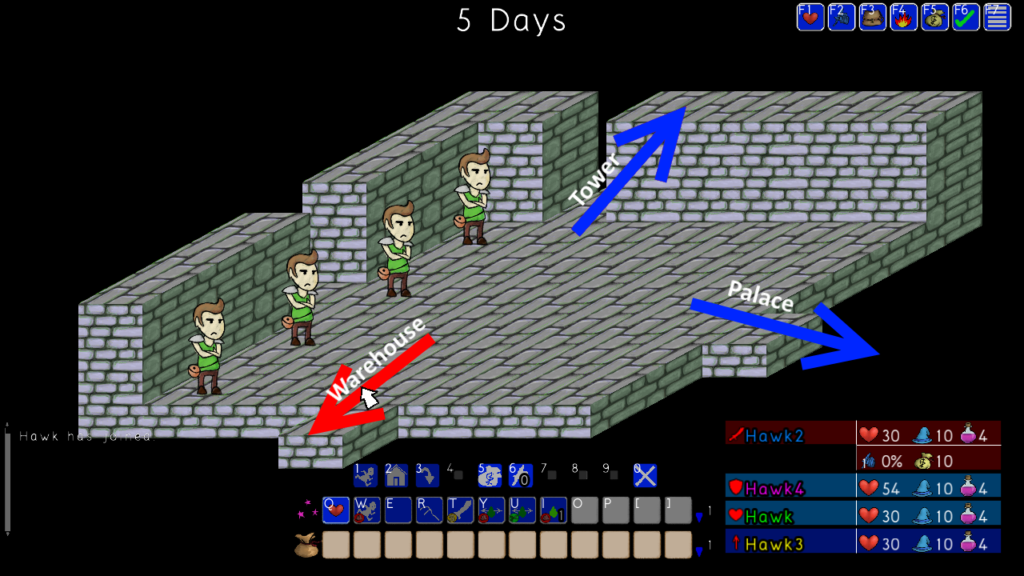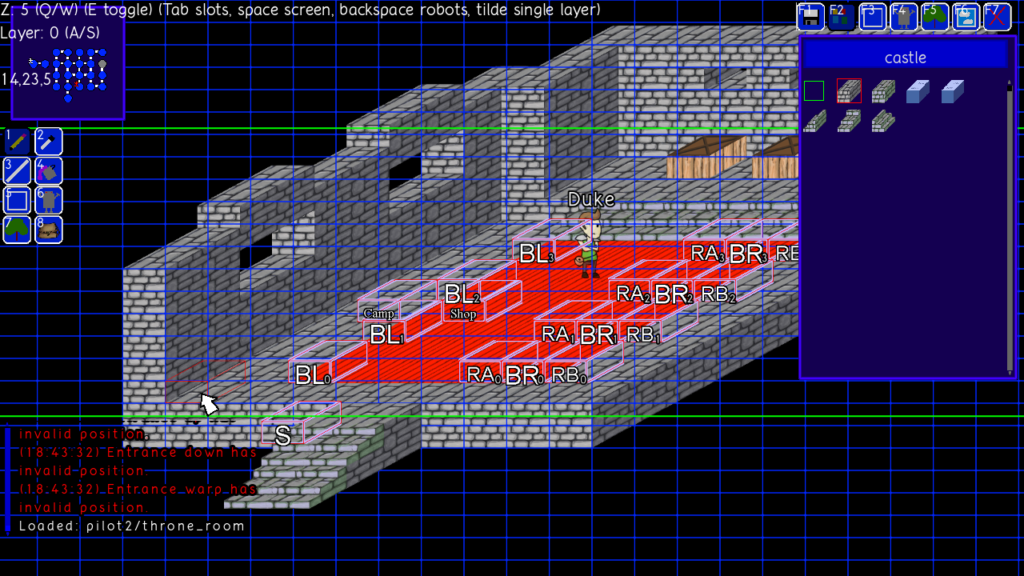With the UI changes being done enough for the time being, and the map readability partially complete I needed to get back to getting something done on the game itself in 2016 just for my own sanity.
October 2016
When we started the project the main goal was always just for a PVP RPG where players competed to beat the main quest before anyone else (occasionally teaming up when necessary, usually to back stab someone else), but when floating wild ideas for other things we could do with the board game setup the idea of a co-op was the one that always hung around. When the game was finally playable enough to try it years later, the response was almost universally more positive than the PVP experience. If I wasn’t an idiot I would have canceled the PVP mode then and there, and we’d be done with this game right now in 2017. Instead we maintained the two as separate modes for years to come (under the idea that we’d have a better chance of appeal with two distinct styles of play), with PVP always getting more attention since it was always the worse (battle lanes and rock paper scissors both stemmed from trying to improve it).
In October I was finally at the end of my rope for trying to improve PVP, and decided to start to combine the two in an effort to improve it. The idea was to make PVP a team based 2v2 affair rather than a free for all with fluid alliances. To that end I had to start building the game in a way that would actively chain teams together, with dead players still tagging along with their party rather than returning to town (in the original co-op modes there were actually some encounters where players would have to split up to fight different monsters simultaneously. It was super cool in concept, but hard to build class team compositions around). My favorite thing about this change is that we still allowed dead players a limited number of abilities in battle- a critical move for a multiplayer game to let players always be engaged.
November 2016
With the push towards making the two modes closer together, November was spent making co-op and PVP share the same classes. It was still pretty tricky making team compositions relevant in both 2-man and 4-man team sizes, but efforts were made to give every class unique PVP abilities to balance out their gaps. The class list as a whole was heavily based on previous co-op classes rather than the old PVP classes, since the new emphasis was on team work for the 2v2 format. Some important design strategies started to fall out of this process, the biggest being the move that saved our progression system by letting players buy upgrades/sidegrades to their core abilities rather than just stat upgrades or entire new abilities- players started feeling stronger rather than accumulating new niche abilities they didn’t have a place to use.
December 2016
The 2v2 mode was finally playable and the result was still underwhelming. Emboldened by my experience of cutting things earlier in the year with the UI, I finally made the hard call. It’s tempting to call it the hardest decision of the project, but maybe it was just the first time I actually made a real decision. I decided to completely cut PVP from the game, leaving only the vague option of a dungeon master mode after release (more to make myself feel better about sunk costs than anything).
I still had to figure out what a fuller co-op mode actually looked like in the new map system, though. We went through a lot of possible options before committing to one that had the lowest immediate cost: the trap and treasure decks would be merged into a single deck, and players would draw a card with each step instead of just once. Layered on top of this we started letting player choose how many steps to move each turn, but also put pressure against them with a turn timer that only let them take so many turns. As such, players had balance moving at a decent speed against the timer without having to draw too many sequential cards at once (enough traps could prove fatal).
The final touch was giving each player “map roles” alongside their battle roles to help them offset the luck of the deck: Leaders who decided how far to move and where to place their limited shortcut warps, support with limited card deck viewing/manipulation abilities, builders who could alter the spaces on the map, and healers who were a mix of support/builders with strictly healing.
January 2017
December’s map system wasn’t terrible. There was a lot of tension in trying to survive a dungeon (probably one of the hardest versions of the game), and it actually did feel a lot like a game. There were two major problems with it: having to do so many bland events in a row (“Got gold!”, “Got damaged!”, “Got Experience!”, etc. made up the bulk) made the game feel like it moved at a snail’s pace, and most of the thematic adventure feel had been drained from the game- it was more like watching your character step on rakes for two hours than a grand adventure.
The more obvious solutions didn’t seem great- reducing the number of events made it harder to create risk/reward decision making, more flavorful events would slow down the pacing further. We eventually settled on one of the more extreme solutions because it solved both problems at once: we’d drop the card system entirely, and instead make each space a unique event related to the scenario. The pressure to randomize the map each game wasn’t really needed for co-op since players would only play each map a few times (compared to a competitive game you’d play over and over with different opponents), and our battle system didn’t really lend itself for replay against the same AI to begin with. With such a system the game would finally start to feel like an adventure again as players had to make choices for each new event, and the pacing would feel much better with fewer events each turn.
February 2017
The static event map system wasn’t necessarily a rip roaring success from tester feedback (bear in mind everything was pretty much textual since we’re talking about a prototype that was stitched together in less than a month), but it hit an important, subtler metric that none of the other tests had done: testers were starting to engage with it as a game instead of an oddity. They’d discuss what equipment they wanted, spend points to advance their characters without prompting, hunted for secrets, and wanted to keep playing until they beat the scenario and saw the ending. For the first time it truly felt like we were on to something we could build on.

With a successful prototype the question moved to “how do we actually present the world to players?”. The answer was the room system which you can read about here.
March-July 2017
While a basic prototype of the room system was tested in February (successful, but limited to the same map for every room and many other limitation), it would take until June for every system to actually mesh with it correctly. June-July were then spent building a map editor to actually construct maps for it (something that was never necessary before since maps were always randomly generated).

August-November 2017
At this point the game’s systems are solidified to the point where there really isn’t a ton to talk about. Smaller changes are still getting made parallel to content development, but not enough to warrant blog posts. While I could discuss the ups and downs of content development, that really seems more appropriate for a postmortem rather than doing it live (not that most players will ever find this blog before playing it anyway). I might change my mind, but don’t expect much more than occasional Update Test Report posts from here on out.
Progress wise we’re up to 3 scenarios out of the target 10. I had really hoped to crank out all 10 in the part of the year dedicated to content so 2018 could focus on polish, but that was hopelessly naive.
A Look Back
What I liked about writing this post is that it became very obvious that from November to February the game was pretty much a different game every month. While this thing has been mutating for years, that was probably the most rapid set of changes in its history. It was all leading up to its final form, and when you look at this post there was an obvious throughline of each version being a reaction to the previous.
I’d like to say that through these 6 years of development with 7-8 massively different versions of the game were all leading up to this final version of the game. But that would be a lie. The reality is that any one of these versions could have been spun out into a full game. The newly discovered fear of commercial failure kept me re-inventing the game instead of committing to a direction. The main issue with most of the versions is just that the map and battle systems conflicted with each other: had I just simplified the battle system I could have fleshed out most of these versions into full games. And frankly most of those RPG-flavored board games probably would have had a much bigger market than the co-op turn based RPG we’ve ended up with after going the other direction and cutting the map systems in favor of the long-refined battle system.
So the next time you know you need to cut something, but don’t want to do it: just cut it.